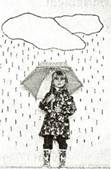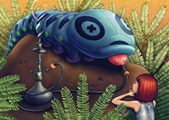题目内容
A young woman was at the cinema,and she was enjoying the film very much.In the next seat there was an old man,and he began looking on the floor under him.The woman was angry and whispered(低声说话),“What are you doing now? What are you looking for?”
“A piece of chocolate(巧克力),”the man whispered to her,“I've dropped it on the floor.”
“A piece of chocolate? ”the woman said angrily,“It s dirty now! Take this and be quiet, please! I'm listening to the film!”She gave the man a big piece of chocolate.
“But.”the man said,“my teeth are in the piece on the floor!”
- 1.
This story took place at the cinema _______.
- A.when the film was on
- B.when the film was over
- C.when the old man was looking for the chocolate
- D.when the woman was whispering to the man
- A.
- 2.
The woman gave the man a big piece of chocolate _________.
- A.so that he could listen to the film
- B.so that he could be quiet
- C.because his chocolate was dirty
- D.because she had too much chocolate
- A.
- 3.
At last the woman knew that the man was looking for _________.
- A.the piece of chocolate
- B.his seat
- C.the big piece of chocolate
- D.his teeth
- A.
- 4.
On the floor lay _________.
- A.neither chocolate nor his teeth
- B.either chocolate or his teeth
- C.both his chocolate and his teeth
- D.chocolate only
- A.
ABDC
试题分析:这篇短文描述了一个发生在电影院的故事.一个年轻人不要意思说找他的牙,就说在找巧克力,一个女人一位给他一块巧克力就可以了.通过对话才知道,原来年轻人的牙粘在巧克力上面了.
1.根据A young woman was at the cinema,and she was enjoying the film very much。及下文描述,可知这个故事发生在电影上映期间。故选A。
2.根据“A piece of chocolate? ”the woman said angrily,“It s dirty now! Take this and be quiet, please! 描述,可知选B,她认为这个男人找到巧克力后就会安静.
3.根据“But.”the man said,“my teeth are in the piece on the floor!”描述,可知这个年轻人的牙粘在巧克力上了.故选D.
4.根据“But.”the man said,“my teeth are in the piece on the floor!”描述,可知这个年轻人的牙粘在巧克力上了.故地板上的是年轻人的牙和巧克力,故选C.
考点:关于一个年轻人找牙的记述文阅读
点评:本文浅显易懂,层次分明,学生很容易把握文中中心内容。答题中注意带着问题阅读短文,一般就能顺利找出答题依据。对于不能直接找到根据的问题注意联系上下文,根据短文中心总结出正确答案。
试题分析:这篇短文描述了一个发生在电影院的故事.一个年轻人不要意思说找他的牙,就说在找巧克力,一个女人一位给他一块巧克力就可以了.通过对话才知道,原来年轻人的牙粘在巧克力上面了.
1.根据A young woman was at the cinema,and she was enjoying the film very much。及下文描述,可知这个故事发生在电影上映期间。故选A。
2.根据“A piece of chocolate? ”the woman said angrily,“It s dirty now! Take this and be quiet, please! 描述,可知选B,她认为这个男人找到巧克力后就会安静.
3.根据“But.”the man said,“my teeth are in the piece on the floor!”描述,可知这个年轻人的牙粘在巧克力上了.故选D.
4.根据“But.”the man said,“my teeth are in the piece on the floor!”描述,可知这个年轻人的牙粘在巧克力上了.故地板上的是年轻人的牙和巧克力,故选C.
考点:关于一个年轻人找牙的记述文阅读
点评:本文浅显易懂,层次分明,学生很容易把握文中中心内容。答题中注意带着问题阅读短文,一般就能顺利找出答题依据。对于不能直接找到根据的问题注意联系上下文,根据短文中心总结出正确答案。

练习册系列答案
相关题目


